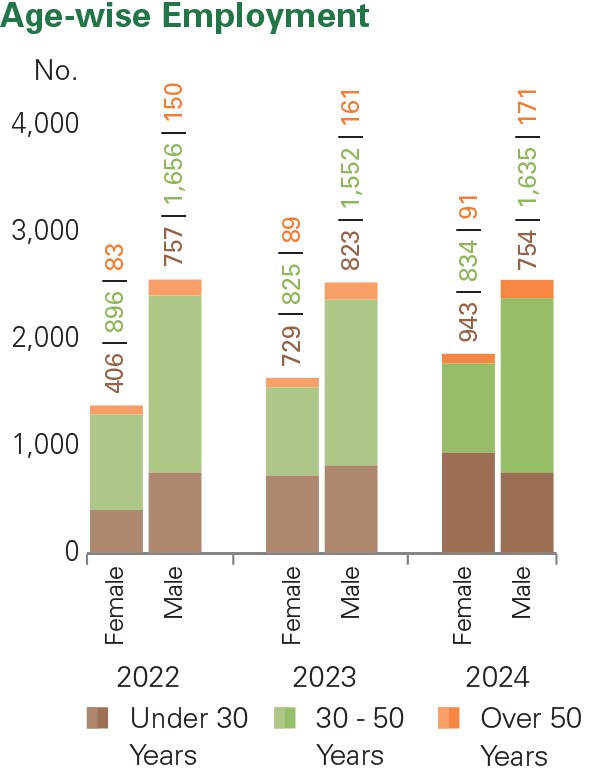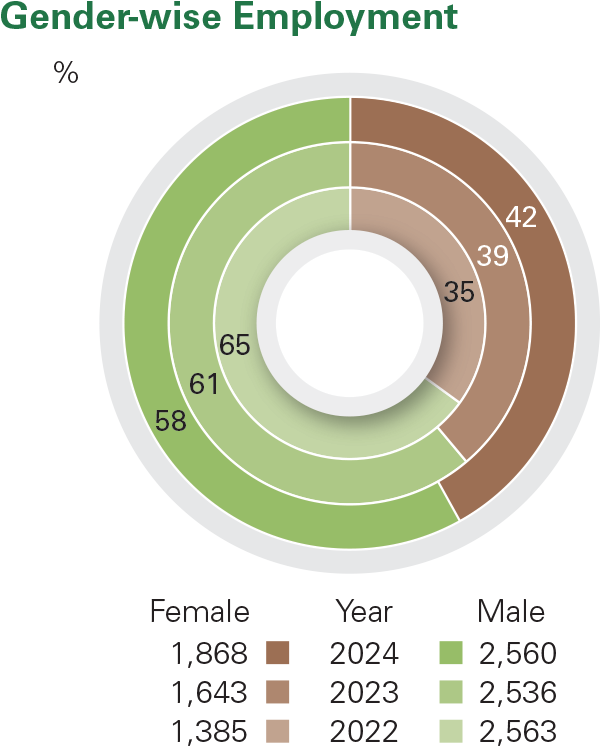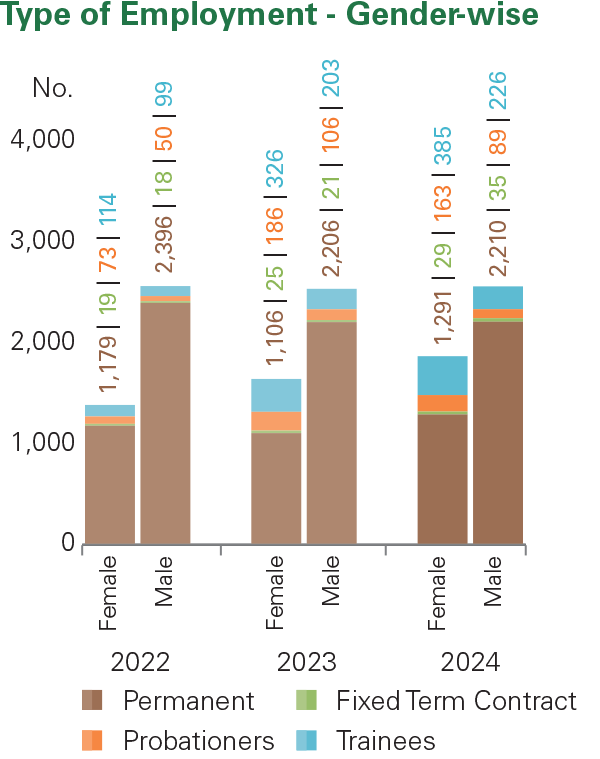Sampath Bank conducts an annual employee satisfaction survey. The Bank recorded an overall satisfaction score of 86% in 2024.

 Human Capital
Human Capital
| Strategic Priorities 2024 | Key Achievements in 2024 | Priorities for 2025 | UN SDG |
|---|---|---|---|
|
HR Governance A comprehensive framework which covers policies, procedures, ethical standards of behaviour and best practices in HR to ensure achievement of stakeholder expectations. |
|
|

|
|
Learning and Development Foster a progressive learning culture that equips team members at all levels with essential skills to meet evolving stakeholder expectations. |
|
|

|
|
Resourcing Enhance talent acquisition efforts to align with new strategies, ensuring the organisation attracts and retains those with necessary skills and qualities for future growth. |
|
|

|
|
Productivity Establish a transparent performance criterion, recognise achievements, and promote open communication. |
|
|

|
|
Employee Engagement Implement indicatives to keep employees engaged and motivated. |
|
|

|
|
Health and Wellbeing Promote a balanced work-life dynamic, supporting employees to thrive personally and professionally while positively impacting their community. |
|
|

|

Employee Satisfaction Ratio

Profit per Employee

Average Training Hours per Employee
Sampath Bank has a comprehensive framework which updates global best practices continuously according to the new applicable human capital related laws which resembles the Bank is highly considerate on HR governance and best practices and creates a worldclass work environment for its employees to develop and enrich. HR Department centrally handles all employee related activities including the recruitment, deployment, performance management, training and development, engagement, rewarding, exit procedures and grievance handling. The adherence to HR governance is the showcase of the Bank’s commitment to manage its employees responsibly and transparently, which is critical for building stakeholder trust further.

Salary adjustments and increments exceeded 20% for all employees, with even greater increases for junior grades.


The policy framework is periodically reviewed and enhanced to reflect the Bank’s evolving demands, ensuring compliance with legal requirements and adherence to adopted standards and certifications. In Q4 2023, the Board authorised a new Code of Conduct, which went into effect on 1st January 2024. To ensure employees are well-informed, a series of training programmes were conducted, with 100% of employees acknowledging receipt of the new Code.

Sampath Bank’s operations are driven by its diversified staff of 4,428 employees, who play a crucial role in supporting the economic growth and job creation within the nation.

The total employment has demonstrated an upward trend, increasing from a headcount of 3,948 in 2022 to 4,179 in 2023, with an additional growth of 249 in 2024.


The Sampath Team is well- balanced, with a mix of young professionals and experienced industry veterans.

The representation of women in the Bank has increased from 2022 to 2023, showing an upward trend, and has reached 1,868 in 2024.

The Bank offers several employment types: fixed term contracts for temporary needs, permanent positions that offer job stability and benefits, probationary roles for new hires and trainee positions which are designed to develop skills for future roles within the bank.

Whilst the age and gender diversity within the workforce contributes to the development of a distinctive culture, the Bank’s broad geographic presence facilitates functional talent mobility across Sri Lanka, increasing operational flexibility.


In addition to the staff employed by the Bank, there are over 1,600 personnel who are engaged through outsourcing arrangements to fulfil various operational needs. These outsourced personnel play an important role in supporting the Bank’s functions and contribute to the overall success.

The Bank closely liaises with outsourced agents and companies to ensure that the security officers receive formal training on human rights and procedures which are relevant to their role. The security personnel are closely monitored by training supervisors who provide feedback on their compliance to the policies.

A higher number of female employees were recruited during the year, with the majority of the total 636 cadre being employees under the age of 30.

During the year a higher percentage (58%) of employees recruited has been female.

Out of total 385 cadre, a higher turnover was observed in the 30 – 50 age group, with most of those departing being male employees.

During the year, the majority of employees who left were male.

A higher number of employees have been recruited from the Western Province, with the majority being female.

The majority of the turnover has been attributed by the Western Province, with other provinces accounting for minor turnover numbers.

The focus is to enhance talent acquisition efforts that align with new strategies, ensuring that the organisation attracts and recruits the right individuals who possess the right skills and qualities needed for future growth. The Bank aims to identify and onboard top talent that fits the current organisational structure as well as promote the innovative strategies.

During the year, the Bank implemented several strategies to manage the recruitment and retention of its employees. These include,

of the new recruits hired are from outside the Western Province
new recruitments during the year
The Bank’s employee turnover data highlights significant trends influenced by various socio-economic factors. The total turnover decreased from 462 in 2023 to 385 in 2024. Migration remains the leading reason for turnover in 2024 as well. This year, 172 team members left the Bank for migration, in addition to 237 members who left in 2023, indicative of skilled professionals seeking opportunities abroad amidst economic instability.


A significant increase in employee benefits, including compensation, was brought on by the substantial rise in the cost of living and higher personal income and consumption taxes. Competitive remuneration has always been a key component of Sampath Bank's approach to attracting and retaining top talent. Salary adjustments and increments exceeded 20% for all employees, with even greater increases for junior grades. The Bank’s remuneration and compensation benefit plans not only adhere to legal requirements but also reflect industry standards and international best practices.

The entry level wage of the Bank is set at Rs 50,000 which is significantly higher than the local minimum wage of Rs 21,000. The Bank’s entry level wage is 2.4 times higher than the local minimum wage.
| Description | Permanent Employees | Contract Employees | Differently-abled Employees |
|---|---|---|---|
| Profit Bonus |  |
 |
 |
| Salary Increment |  |
On renewal of agreement |  |
| Allowances (as applicable) |  |
 |
 |
| Reimbursement of Course Fees/Exam Fees |  |
- |  |
| Medical Facilities |  |
- |  |
| Holiday Bungalow Facilities |  |
 |
 |
| Special Non-technical Training |  |
 |
 |
| Special Programmes for Children of Employees |  |
 |
 |
| Death Benefit |  |
 |
 |
The Bank has taken the initiative to cultivate a performance-oriented work culture that prioritise accountability and results. The Bank is dedicated to developing a transparent performance criterion, recognising achievement and encouraging open communication. Through fostering collaboration and providing essential resources and support, the Bank aims to inspire its workforce to achieve and align their ambitions with the organisation’s objectives, driving collective success.

Profit per Employee
Gross Income per Employee
The focus is to cultivate a progressive learning culture that nurtures high-performing, value- driven team members across all levels. This approach aims to equip employees with the skills and knowledge necessary to effectively meet the evolving expectations of stakeholders, both now and in the future.
The training coverage includes team members of the Bank (Team Sampath), interns and industrial placements, as well as the public, based on specific requirements. All employees have equitable access to job-specific training and other capacity-building activities to support their individual career goals. The Bank has increased its emphasis on training for all employee categories in response to issues with employee attrition brought on by the current economic crisis.
The Bank’s training and development are conducted based on the Bank’s distinctive competency framework, which encompasses 15 key competencies.

Investment in training and professional studies
Programmes conducted
Trained employees
Training hours
Delivery mode
in classroom
online


of employees received regular performance and career development reviews
| No. | Competency Area | Number of Participants | Training Hours |
|---|---|---|---|
| 1 | Operations (Cash/Accounts Opening/Pawning/Cheques/Clearing/Credit cards) | 20,979 | 21,044 |
| 2 | Credit and Recoveries (Credit/Recovery/SME/Micro Finance) | 5,899 | 19,622 |
| 3 | International Operations (Trade/Foreign Currency Operations) | 2,487 | 3,300 |
| 4 | Risk and Compliance (AML) | 1,078 | 2,019 |
| 5 | Finance and Accounting | 1,066 | 4,777 |
| 6 | Marketing (Products/Branding) | 1,141 | 1,526 |
| 7 | Human Resource Management/Health and Wellbeing | 2,478 | 5,981 |
| 8 | Legal and Good Governance | 526 | 769 |
| 9 | Other Technical Programmes (Treasury etc.) | 3,117 | 11,117 |
| 10 | Orientation Programmes | 4,995 | 34,033 |
| 11 | Customer Service Excellence and Selling Skills | 3,713 | 33,309 |
| 12 | Leadership and Management (Competency Development Programmes/Strategic Management/Change Management) | 1,945 | 8,255 |
| 13 | IT Skills (Core Banking System/Digitalisation/Project Management/E-Commerce etc.) | 1,178 | 3,421 |
| 14 | Communication Skills (Business Writing/Effective Communication) | 281 | 1,970 |
| 15 | Other Non-Technical Skills (Train the Trainer etc.) | 2,016 | 3,589 |
| 16 | Learn with Vidvan - LMS (number of times participants logged into LMS) | 39,142 | 44,554 |
| Grand Total | 92,041 | 199,286 |
The Bank has implemented a variety of initiatives aimed at keeping its workforce engaged and motivated, including professional development opportunities, team building activities, and recognition programmes that celebrate individuals’ and team achievements. The Bank encourages employees to actively participate, fostering a sense of ownership and collaboration.

In appreciation of long service employees

Leadership and personal development programme for children of employees






|
The Buddhist Association

|
The Photographic Club

|
Toastmasters Club

|
|---|---|---|
|
|
|
|
CSR
Initiatives

|
Women
Empowerment
Initiatives

|
Sports
Club

|
|---|---|---|
|
|
|
Sampath Bank conducts an annual employee satisfaction survey. The Bank recorded an overall satisfaction score of 86% in 2024.


Sampath Bank's health and wellbeing programmes are designed to promote a balanced work-life dynamic, allowing employees to thrive both personally and professionally while making a positive impact in their communities. The Bank recognises that achieving overall success involves not only meeting professional goals but also nurturing personal wellbeing. To this end, the Bank is dedicated to safeguarding the mental, emotional, and physical health of its staff through a holistic approach to wellbeing. This includes offering resources such as mental health support, fitness initiatives, and health check-ups that empower employees to prioritise their health. By doing so the Bank aims to enhance employee satisfaction and productivity, which leads to improving both the employee and organisation.
The Bank is committed to facilitating access to non-occupational medical and healthcare services for its employees and their families.

Medical Cover
number of claims during the year
spent during the year
Counselling Cell
employees benefited
spent during the year
Critical Illness and Cancer Funds
number of claims during the year
spent during the year
Comprehensive health and safety training is provided to all employees.



The Bank remains dedicated to increasing awareness about the prevention of Non-Communicable Diseases (NCD) while implementing various initiatives to encourage healthy lifestyles and enhance overall wellness. These efforts include hosting an Annual Health Conference and conducting awareness programmes on vision care, dental screenings, and breast cancer, among other topics.

Benefited 150 employees

Benefited 43 employees

Benefited 80 employees

Benefited 172 employees

Benefited 29 employees

Benefited 132 employees

Benefited 100 employees

Benefited 100 employees
Sampath Bank actively encourages diversity and inclusion in the workplace, guided by its values of equal opportunity and non-discrimination. By implementing a zero-tolerance policy for harassment and discrimination, the Bank ensures that every employee has equal opportunities to contribute to its success, whilst leveraging their unique skills and working with colleagues

| 2024 | ||
|---|---|---|
| Quarter | Male | Female |
| Q1 | 59 | 41 |
| Q2 | 58 | 42 |
| Q3 | 58 | 42 |
| Q4 | 58 | 42 |
In 2024, Sampath Bank maintained a relatively stable gender composition across all quarters, demonstrating its commitment to workforce diversity. The year began with a male-to-female ratio of 59:41 in Q1, which slightly adjusted to 58:42 for the remaining three quarters of the year. This consistency in gender distribution reflects the Bank's sustained efforts to maintain a balanced workforce, though there remains opportunity for further progress toward gender parity.


| 2024 | 2023 | |||
|---|---|---|---|---|
| Description | Male | Female | Male | Female |
| Corporate Management | 1.00 | 1.00 | 1.00 | 1.00 |
| Senior Management | 1.00 | 1.04 | 1.00 | 1.00 |
| Executive Management | 1.00 | 1.00 | 1.00 | 1.00 |
| Middle Management | 1.00 | 0.99 | 1.00 | 0.97 |
| Junior Management | 1.00 | 1.05 | 1.00 | 1.02 |
| Operational Staff | 1.00 | 0.95 | 1.00 | 0.86 |
The ratio of basic salary at the entry level for male and female is 1 : 1. However, this ratio may change due to different service periods of employees in the Bank and elevation of the salary grade due to promotions.

The Bank has implemented numerous initiatives aimed at empowering women, conducting programmes that support their professional development, leadership opportunities, and health and wellbeing. These initiatives aim to create an inclusive environment that fosters women’s development and advancement both within the organisation and in the community.

Sampath Bank actively promotes women’s empowerment through affirmative action programmes, ensuring both parents receive the support they need during the time.
| Female | Male | Total | |
|---|---|---|---|
| Total number of employees that were entitled to parental leave by gender | 1,868 | 2,458 | 4,326 |
| Total number of employees that utilised parental leave by gender | 26 | 79 | 105 |
| Total number of employees that returned to work in the reporting period after parental leave (excluding female staff who were on maternity leave as of 31st December 2024) | 17 | 79 | 96 |
| Total number of employees that returned to work after parental leave ended that were still employed 12 months after their return to work by gender (12 months considered from 1st January 2024 to 31st December 2024) | 53 | 39 | 92 |
| Return to Work Rate [%] | 94.4 | 100.0 | 99.0 |
| Retention Ratio [%] | 91.4 | 88.6 | 90.2 |


The Bank offers parental leave policies to support work-life balance. During the year, 4,326 employees were eligible, and 105 employees utilised parental leave. A total of 96 employees returned to work and the return-to-work rate was 94.4% for women and 100% for men, whilst the retention ratio was 91.4% for women and 88.6% for men. These metrics indicate the prevalence of a conducive work environment for parents of infant children and the support provided by the Bank towards work-life balance.
The Bank has implemented numerous initiatives aimed at empowering women, conducting programmes that support their professional development, leadership opportunities, and health and well-being. These initiatives aim to create an inclusive environment that fosters women’s development and advancement both within the organisation and in the community.


The Bank has undertaken various initiatives specifically aimed at promoting women and increasing engagement, including competitions that celebrate their achievements and health and wellbeing programmes which have been designed to promote their holistic development.

75 participants

60 participants

15 branches/departments participated

25 participants

40 participants
Despite the absence of an official collective bargaining agreement, 98% of Sampath Bank employees are members of an internal, politically unaffiliated employees' association. However, the Bank engages in collective bargaining with the Sampath Bank Employees’ Association (SBEA) with regard to matters concerning employees. Both the Bank and the SBEA are dedicated to fostering a cooperative relationship in decision-making processes.
The Bank remains committed to upholding human rights and has in place the following grievance mechanisms to enable employees to draw attention of management to any potential or actual violations.